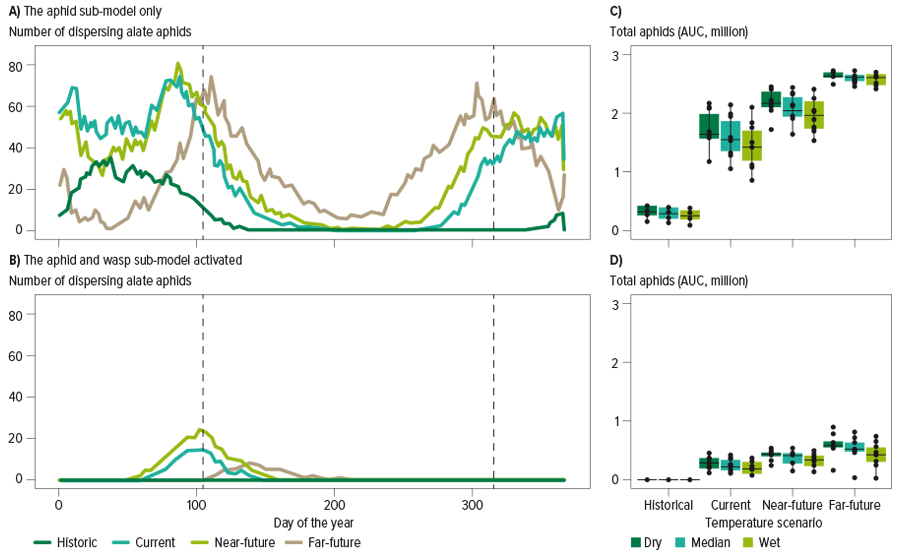Digital technology is integrating knowledge on invertebrate pests, weather conditions, beneficial insects and crop dynamics to inform in-paddock decisions.
As knowledge increases about the life cycle, damage potential and distribution of emerging crop pests such as earwigs and millipedes, existing knowledge of well-studied pest species such as aphids needs to be drawn upon in support.
For example, understanding when aphid population outbreaks may occur, and what support beneficial insects might provide to control these outbreaks, is an important step towards optimising the time of spraying to avoid the loss of beneficials and maximise grain yield.
Computer simulation
Forecasting pest outbreaks requires knowing how their movements and population dynamics are affected by climatic factors, such as temperature and rainfall, as well as the dynamics of the crop itself. Accounting for the responses of beneficial insects to these factors, as well as the pest and interactions between them (for example, parasitism rates), can give valuable insights into the potential for biological control.
Researchers have now developed a computer model that can simulate the population dynamics of green peach aphid and its parasitoid wasp (Diaeretiella rapae) across southern grain growing regions. Such integration of knowledge through modelling is bringing us closer to digital solutions that growers can use to protect crops.
Figure 1: The number of dispersing alate (winged) aphids predicted by the model without (A) and with (B) parasitoid wasps across a range of temperature scenarios (see key). The line graphs on the left show the expected population dynamic across a calendar year under these scenarios. The graphs on the right show the additional effect of rainfall on the total aphid population: wetter conditions tend to suppress aphid populations under all scenarios.

Source: CSIRO
Vision for the future
Digital decision support for pest and disease control across Australia has been estimated to have the potential to unlock $1 billion of economic benefits. Improved access to computers, handheld devices and the internet’s increasing reach into remote areas are making such tools more accessible.
How might computer simulation models evolve into ‘digital IPM’ tools? Picture this: a grower is in a canola crop. A notification flashes on their mobile phone, alerting to a report on the latest insect monitoring data sent from multiple sensors around the farm indicating early signs of green peach aphid activity.
The grower opens the insect pest management app. Live data from the Bureau of Meteorology, local weather stations and current crop information is fed into the model which provides a detailed, short-term forecast of what is likely to happen next for any established aphid colonies. The app also indicates there is a high level of beneficial insect activity in and around the field, based on automated image recognition of parasitic wasps in sticky traps.
This, too, is fed into the model, which reveals there is low risk in relying on parasitoids to deal with any potential aphid outbreaks, and therefore no real need to spray pesticide.
Making ‘digital IPM’ reality
This technology almost entirely exists already. The problem has been the need to open and crosscheck data from multiple apps and models. However, Australian researchers have developed a flexible digital framework known as Digiscape, which can integrate multiple types of data (from automated insect traps to weather stations) with forecasting models into user-friendly, decision-support tools (Figure 2). This is a good example of the potential of digital technology for IPM now being unlocked.
Figure 2: A schematic of ‘digital IPM’: integration of monitoring, forecasting and decision-making across multiple devices and platforms to provide real-time pest management solutions.

Source: CSIRO
More information: Dr Hazel Parry, CSIRO, 07 3833 5681, hazel.parry@csiro.au

























































